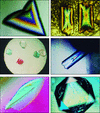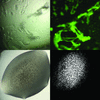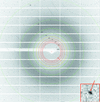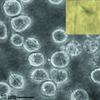issue contents
Top articles in structural biology (Spring 2020)
This virtual issue presents some of the best structural biology articles published in IUCr journals selected by Roberto Steiner, the Commissioning Editor for Biology.

Cover illustration: IUCr Journals covering structural biology.
Open  access
access
 access
accessCo-crystal structures of P-glycoprotein with a series of engineered ligands reveal multiple ligand-binding modes, a ligand-binding site on the outer surface of the transporter and a conformational change that may couple to ATP hydrolysis.
Open  access
access
 access
accessA raster scanning serial protein crystallography approach is presented, that consumes as low ∼200–700 nl of sedimented crystals. New serial data pre-analysis software, NanoPeakCell, is introduced.
Download citation


Download citation


Open  access
access
 access
accessA method for performing high-throughput in situ serial X-ray crystallography with soluble and membrane proteins in the lipid cubic phase at cryogenic temperatures (100 K) is described. It works with nanogram to single-digit microgram quantities of protein and lipid (and ligand when present), and is compatible with both high-resolution native data collection and experimental phasing without the need for crystal harvesting.
Open  access
access
 access
accessThe motivation for, and the first results from, the novel in-vacuum long-wavelength MX beamline I23 at Diamond Light Source are presented.
PDB reference: thaumatin, 4zg3
High-throughput, room-temperature serial crystallography using a slow stream is demonstrated at a synchrotron source. The data quality is sufficiently good to allow de novo phasing.
Open  access
access
 access
accessA comprehensive and up-to-date review of the lipid cubic phase or in meso method for crystallizing membrane and soluble proteins and complexes is reported. Recent applications of the method for in situ serial crystallography at X-ray free-electron lasers and synchrotrons are described.
The gateway to X-ray crystallography is the growth of macromolecular crystals. An attempt is made here to acquaint investigators with the principles and practice of protein crystallization, some recent innovations, and to touch upon some of the remaining problems.
Open  access
access
 access
accessAn understanding of protein stability is essential for optimizing the expression, purification and crystallization of proteins. In this review, discussion will focus on factors affecting protein stability on a somewhat practical level, particularly from the view of a protein crystallographer.
Microseed matrix screening is increasingly successful in the optimization of protein crystallization leads.
Strategies and procedures for the optimization of macromolecular crystal-growth conditions are surveyed. The objective of optimization is to grow crystals with the greatest degree of perfection and that yield the most accurate and precise X-ray diffraction data.
The room-temperature structure of lysozyme is determined using 40000 individual diffraction patterns from micro-crystals flowing in liquid suspension across a synchrotron microfocus beamline.
PDB reference: lysozyme by serial crystallography, 4o34
The structure solution of T. brucei cathepsin B from 80 in vivo grown crystals with an average volume of 9 µm3 obtained by serial synchrotron crystallography at a microfocus beamline is reported.
PDB reference: cathepsin B, 4n4z
This article describes the structure determination of a membrane protein by serial injection of microcrystals in lipidic cubic phases into a synchrotron microfocus beam. The method is discussed with respect to serial femtosecond crystallography at free-electron lasers.
The use of X-ray lasers to obtain structures and molecular movies in biology is reviewed. Methods include single-particle imaging, serial crystallography and fast solution scattering at room temperature.
Neutron crystallography and sub-atomic X-ray crystallography complement each other in defining hydrogen positions in macromolecules. Significant advances have been made but much effort is still required if neutron crystallography is to become a mainstream activity.
PDB reference: 5akr


 menu
menu




























